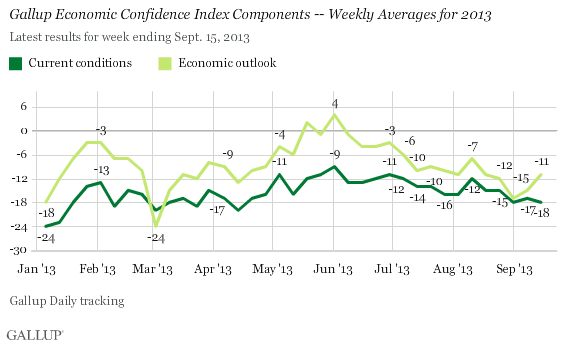WASHINGTON, D.C. -- Americans' confidence in the U.S. economy improved slightly over the past two weeks. Gallup's U.S. Economic Confidence Index was -15 last week, similar to the -16 from the previous week, but up from -18 in the week ending Sept. 1. However, Americans continue to be less positive about the economy than they were in May and June.

Gallup's Economic Confidence Index started the year at a lower level after the fiscal cliff deal was reached at the end of 2012, but steadily improved into early February. The index fell sharply after federal budget sequestration cuts took effect in early March, but quickly recovered once again. Americans' confidence in the economy peaked in late May and early June at -3, which is also the best weekly average since Gallup began tracking this metric daily in January 2008. Since early June, Americans' confidence in the economy has generally declined, possibly due to increasing mortgage rates, mixed employment news, and U.S. stock-price volatility that came amid uncertainty over when the Federal Reserve would taper its bond-buying program.
Gallup's Economic Confidence Index is based on Americans' ratings of current economic conditions in the U.S. and their assessments of whether the economy is getting better or worse. The three-point increase in the overall index over the past two weeks is solely due to Americans' rosier economic outlook.
Last week, 42% of Americans said the economy is getting better and 53% said it is getting worse, for a net economic outlook score of -11, six points higher than the -17 in the week ending Sept. 1.
Seventeen percent of Americans rate current economic conditions as "excellent" or "good," while 35% rate them as "poor." That results in a -18 net current conditions score, identical to what Gallup found for the week ending Sept. 1.

Bottom Line
While Americans remain more negative than positive about the U.S. economy overall, Gallup's Economic Confidence Index is significantly better than it was five years ago, in the days immediately before and after Lehman Brothers collapsed and a global economic meltdown ensued.
Although Americans' economic confidence has slightly improved over the past two weeks, there are several looming political and economic events that could negatively affect confidence: the situation in Syria, debates in Washington over the federal budget and the debt ceiling, and the Federal Reserve's decision on when and by how much to slow down its bond-buying program.
Gallup.com reports results from these indexes in daily, weekly, and monthly averages and in Gallup.com stories. Complete trend data are always available to view and export in the following charts:
Daily: Employment, Economic Confidence, Job Creation, Consumer Spending
Weekly: Employment, Economic Confidence, Job Creation, Consumer Spending
Read more about Gallup's economic measures.
View our economic release schedule.
Survey Methods
Results for this Gallup poll are based on telephone interviews conducted Sept. 9-15, 2013, on the Gallup Daily tracking survey, with a random sample of 3,568 adults, aged 18 and older, living in all 50 U.S. states and the District of Columbia.
For results based on the total sample of national adults, one can say with 95% confidence that the margin of sampling error is ±2 percentage points.
Interviews are conducted with respondents on landline telephones and cellular phones, with interviews conducted in Spanish for respondents who are primarily Spanish-speaking. Each sample of national adults includes a minimum quota of 50% cellphone respondents and 50% landline respondents, with additional minimum quotas by region. Landline and cell telephone numbers are selected using random-digit-dial methods. Landline respondents are chosen at random within each household on the basis of which member had the most recent birthday.
Samples are weighted to correct for unequal selection probability, nonresponse, and double coverage of landline and cell users in the two sampling frames. They are also weighted to match the national demographics of gender, age, race, Hispanic ethnicity, education, region, population density, and phone status (cellphone only/landline only/both, and cellphone mostly). Demographic weighting targets are based on the March 2012 Current Population Survey figures for the aged 18 and older U.S. population. Phone status targets are based on the July-December 2011 National Health Interview Survey. Population density targets are based on the 2010 census. All reported margins of sampling error include the computed design effects for weighting.
In addition to sampling error, question wording and practical difficulties in conducting surveys can introduce error or bias into the findings of public opinion polls.
For more details on Gallup's polling methodology, visit www.gallup.com.
